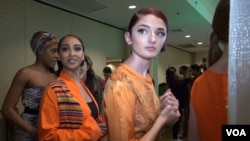Fashion designer Ellen London uses textiles from all over the world in her designs, sometimes mixing them — combining a Thai fabric, for example — with one from the U.S. Appalachian region.
“I believe that textiles and fashion have an idea to teach people about understanding and connection of different cultures through fabric,” London told VOA during a recent showing during (Washington) DC Fashion Week.
As a former Peace Corps volunteer, London discovered what she calls her “gypsy” spirit. It has taken her all over the world in search of native textiles that she converts into “wearable” art with the help of her Thai design partner and a group of female tailors.
According to her website, her collection includes “East and West African wax and printed fabrics, washed silks and cotton wovens from Thailand, and designer-created Japanese Shibori and Nigerian Adire batik techniques on some of our new designs. Indigo and batik have found their place on virtually every continent.”
Color and texture aside, London said her work is about “respect and including people, rather than excluding them.”
London is a natural for DC Fashion Week because she fits the vision of event founder Ean Williams, who sees Washington, D.C., “as the center of international fashion.”
DC? Fashion?
Ride the subway in Washington, and it will quickly become apparent that the nation’s capital is not a couture town. Residents dress conservatively, if not in clothes that are often stodgy.
To Williams, this is a waste of considerable opportunity.
“D.C., of course, is known for politics,” he mused. “But there are so many things to do in Washington, from opera to museums to concerts to theater to great poolside parties to mainstream society events to after-parties. There are so many great opportunities for people to dress to impress.”
Williams combines politics with Hollywood glamour to label his vision of Washington “Pollywood.”
For the past 14 years, he has staged fashion week twice a year. DC Fashion Week started with local designers showcasing their collections and has evolved into an international event, attracting designers from all over the world.
The DC Fashion Week organization is a nonprofit, so most of the costs are donated by vendors and sponsors. As a result, designers can show their collections at minimal cost, making the event affordable to young designers and international ones.
“Trying to participate in other shows can become very expensive for a designer. So, participating in DC is just a great opportunity,” said swimsuit designer Camile Case, who is from Jamaica.
As always, the 29th fashion week took place in a variety of venues — this fall at Madame Tussaud’s Wax Museum and the French embassy. Each sold-out event featured a different category of designer, including emerging talent and international couturiers.
“The hope and goal of fashion week … is that every country send their best designer and talent to showcase, like the Olympics,” said Williams, who is a self-taught designer himself. “We want to show what the fashion community of the world has to offer to the consumer.”
Models & guests
DC Fashion Week, unlike fashion weeks in other cities, provides an opportunity for models with many backgrounds and different shapes.
From Nigeria, Bukola Aeosun was participating in her second fashion week. “I like the diversity in races and colors and textures and sizes. I think that is very empowering and it’s exciting.”
“Fashion is for everyone,” Williams said. “We started with inclusivity. We started with having diverse models, models of different sizes, models of different ages.”
The audience is diverse, too. From Pakistan, Maliha Cheema attended fashion week for the first time.
“I really enjoyed the show,” she said. “I love how inclusive it was. There are models of every size, and there is a hijabi and everything.”
https://www.voanews.com/a/dc-fashion-week-links-cultures-with-style-/4591152.html



No comments:
Post a Comment